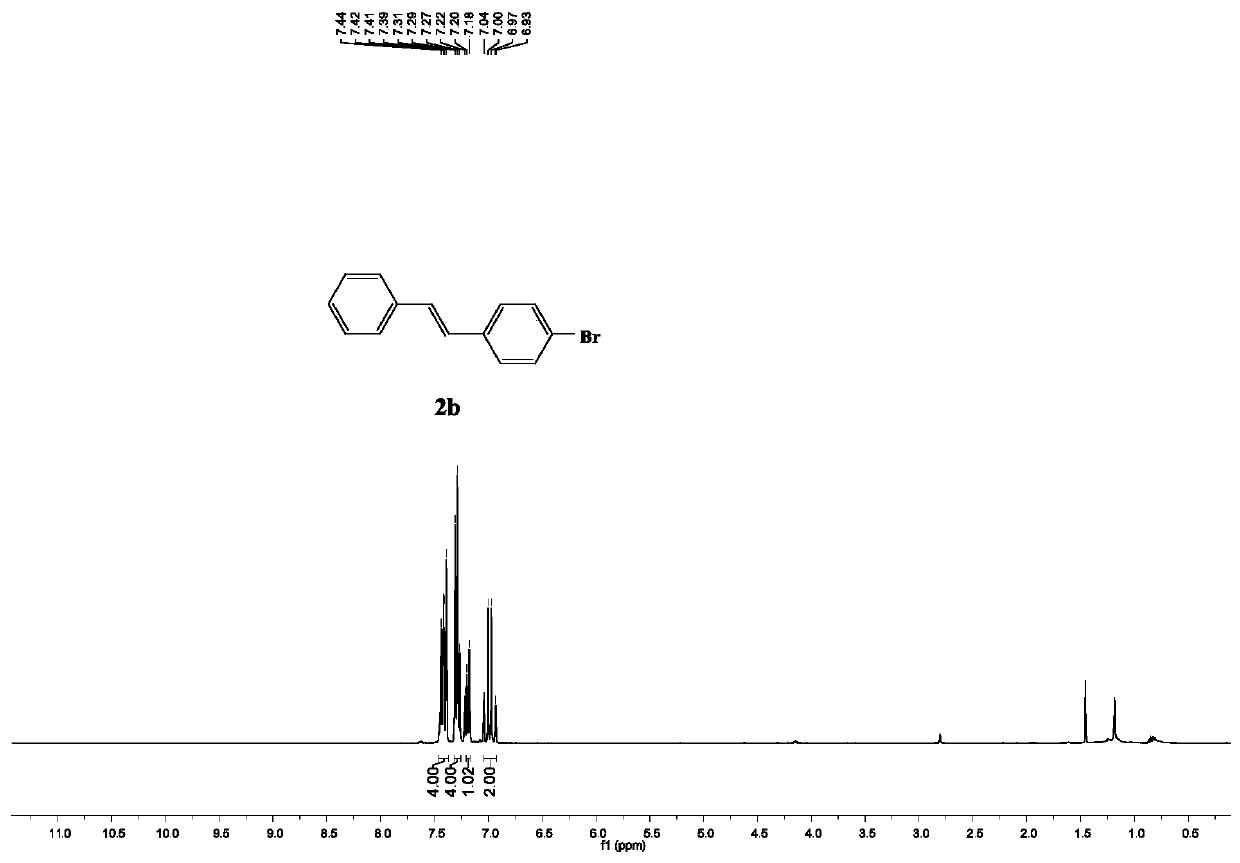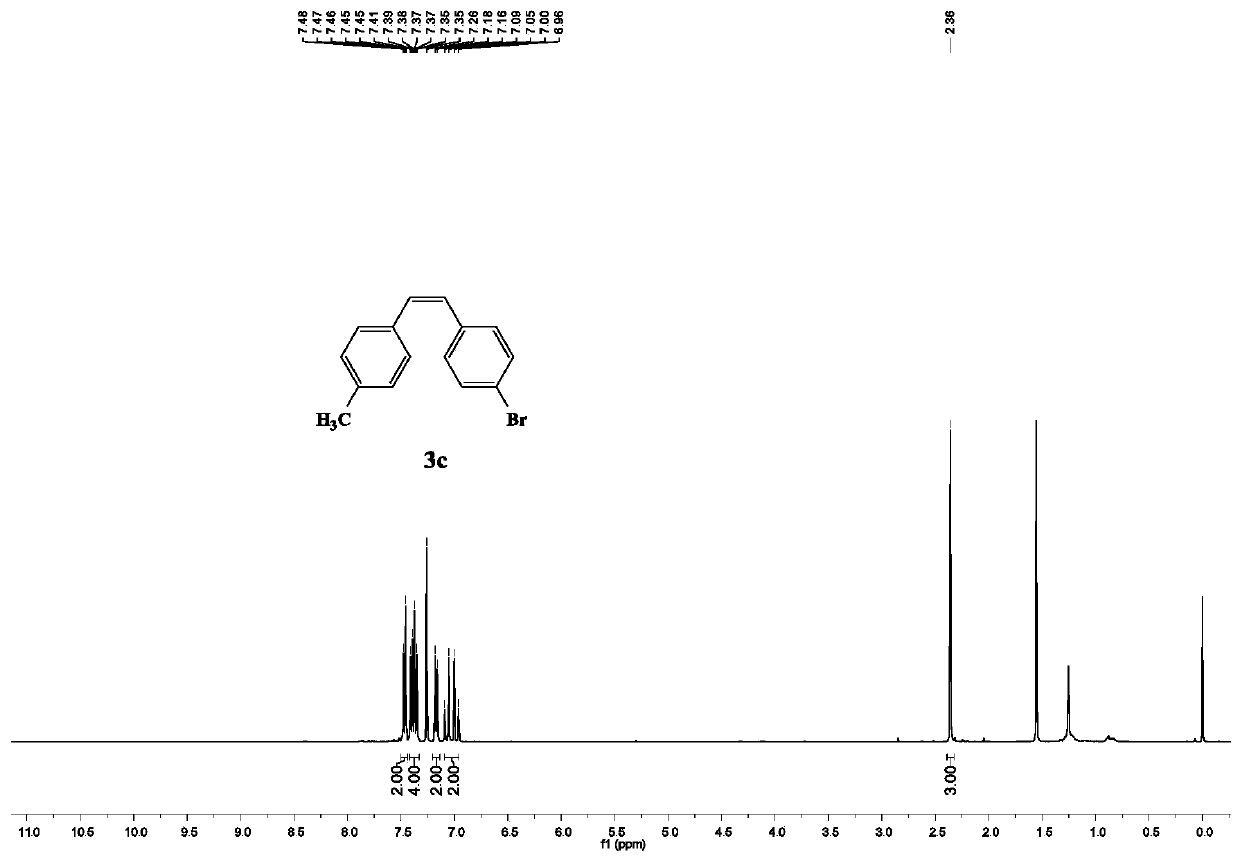Photo-induced catalytic method for selectively synthesizing cis olefin and trans olefin by using alcohol as hydrogen source
A light-induced and selective technology, which is applied in the field of pharmaceutical and chemical applications, can solve the problems that it is difficult to realize the selective synthesis of cis- and trans-alkenes at the same time, it is unfavorable for large-scale industrial production, and it is difficult to obtain trans-alkenes. Catalytic effect, convenient post-treatment process, low catalyst consumption
- Summary
- Abstract
- Description
- Claims
- Application Information
AI Technical Summary
Problems solved by technology
Method used
Image
Examples
Embodiment 1
[0048] Synthesis of (E)-1,2-Diphenylethylene:
[0049]
[0050] Add raw material 1a (0.20mmol), Ir(ppy) into the reaction flask 3 (10μmol, 8.4 mg), PdCl 2 (0.04mmol, 7.1mg), DPPE (0.04mmol, 15.9mg), TEOA (0.4mmol), EtOH (0.4mmol) and acetonitrile (1.5mL), in an air atmosphere, stirring at room temperature under white light irradiation for 16 hours, adding ethyl acetate Ester (5mL) was diluted, washed with saturated brine (5mL), the organic phase was dried with anhydrous magnesium sulfate, spin-dried and column chromatography, the eluent was (n-hexane), product 2a was obtained as a white solid 32mg, yield 90 %. 1 H NMR(400MHz, CDCl 3 ): 7.49(d,J=8.0Hz,4H), 7.34(t, J=8.0Hz,4H), 7.26–7.22(m,2H), 7.09(s,2H); 13 C NMR(100MHz, CDCl 3 ) 137.4, 128.8, 127.7, 126.6.
Embodiment 2
[0052] (E) Synthesis of 1-bromo-4-styrylbenzene:
[0053]
[0054] Add raw material 1b (0.20mmol), Ir(ppy) into the reaction flask 3 (10μmol, 8.4 mg), PdCl2 (0.04mmol, 7.1mg), DPPE (0.04mmol, 15.9mg), TEOA (0.4mmol), EtOH (0.4mmol) and acetonitrile (1.5mL), in an air atmosphere, white light irradiation Stir at room temperature for 16 hours and add ethyl acetate (5mL) to dilute, wash with saturated brine (5mL), dry the organic phase with anhydrous magnesium sulfate, spin dry and column chromatography. The eluent is (n-hexane) to obtain product 2b It is a white solid 42 mg, and the yield is 81%. 1 H NMR(400MHz, CDCl 3 ): 7.48–7.43(m,4H), 7.35–7.31 (m,4H), 7.23(d,J=8.0Hz,1H), 7.07(dd,J=24.0,12.0Hz,2H); 13 C NMR(100MHz, CDCl 3 ) 137.1, 136.4, 131.9, 129.6, 128.9, 128.1, 128.1, 127.6, 126.7, 121.5.
Embodiment 3
[0056] (E) Synthesis of 1-chloro-4-styrylbenzene:
[0057]
[0058] Add 1c (0.20mmol), Ir(ppy) to the reaction flask 3 (10μmol, 8.4 mg), PdCl2 (0.04mmol, 7.1mg), DPPE (0.04mmol, 15.9mg), TEOA (0.4mmol), EtOH (0.4mmol) and acetonitrile (1.5mL), in an air atmosphere, white light irradiation Stir at room temperature for 16 hours and add ethyl acetate (5mL) to dilute, wash with saturated brine (5mL), dry the organic phase with anhydrous magnesium sulfate, spin dry and column chromatography. The eluent is (n-hexane) to obtain product 2c It is a white solid 36mg, the yield is 84%. 1 H NMR(400MHz, CDCl 3 ): 7.50 (d, J = 8.0 Hz, 2H), 7.44 (d, J = 8.0 Hz, 2H), 7.38-7.25 (m, 5H), 7.07 (dd, J = 20.0, 16.0 Hz, 2H); 13 C NMR(100MHz, CDCl 3 ) 137.1, 136.0, 133.3, 129.5, 129.0, 128.9, 128.0, 127.8, 127.5, 126.7.
PUM
 Login to View More
Login to View More Abstract
Description
Claims
Application Information
 Login to View More
Login to View More - R&D
- Intellectual Property
- Life Sciences
- Materials
- Tech Scout
- Unparalleled Data Quality
- Higher Quality Content
- 60% Fewer Hallucinations
Browse by: Latest US Patents, China's latest patents, Technical Efficacy Thesaurus, Application Domain, Technology Topic, Popular Technical Reports.
© 2025 PatSnap. All rights reserved.Legal|Privacy policy|Modern Slavery Act Transparency Statement|Sitemap|About US| Contact US: help@patsnap.com



